hankyoreh
Links to other country sites 다른 나라 사이트 링크
[Korea travels] Forget Haeundae and Gwangalli: A real traveler’s guide to enjoying Busan
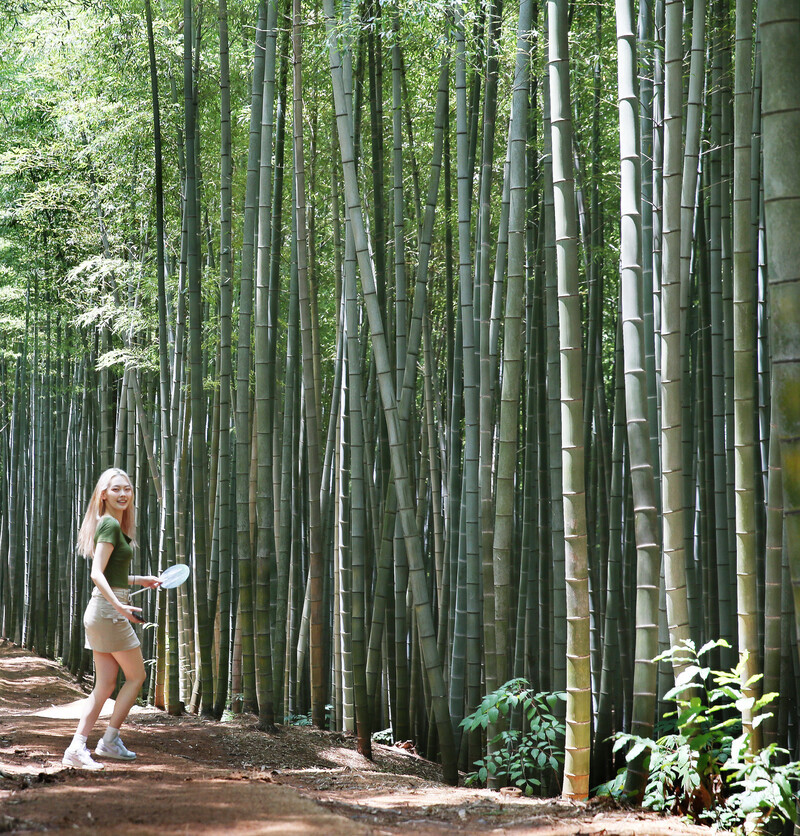
One of the latest trends when traveling to Busan is skipping the beaches at Haeundae and Gwangalli.
Contemporary people who have made travel part of their routine feel compelled to find new places to go and things to do. For such people, Haeundae and Gwangalli, which are Busan’s best-known beaches, feel boring and stereotypical.
That’s not where travel trendsetters go on their trips to Busan. I visited four of Busan’s hippest destinations on a three-day trip on July 20 on behalf of those who are planning a trip to Busan for the summer holiday.

Moisture was in the air at Ahopsan Forest (located in Cheolma Township, Gijang County, Busan) when I arrived just after noon on July 21. The tree branches stretching into the sky rustled in the breeze.
Ahopsan is named for the nine peaks in the area. But there’s no need to be intimidated by the word “peak” — these are mild and modest hills, and the tallest only has an elevation of 361 meters. The forest in the area covers 528,952 square meters.
Past the ticket office, the first thing to greet me was a colony of pine trees. These trees, which are more than 400 years old, have been designated for special care by Gijang County. Given the prevalence of pine trees on the Korean Peninsula, I wasn’t particularly impressed by the scenery here.
But after a couple minutes’ walk, the forest unveiled its true charm near a sign that said “Maengjong Grove at the Shamanistic Ritual Site.” There was a modestly sized clearing here hemmed in by dense thickets of maengjong, a kind of bamboo.
An old story is told about the clearing. Noting that bamboo didn’t grow there, the local villagers believed it was under the sway of guardian spirits from the nine mountains.
Whenever misfortune struck the village, they had the local shaman perform a ritual in the clearing. The bamboo trees around the clearing bore witness to people’s hopes and fears.
The bamboo trees grow to a height of 10-20 meters and are quite thick, up to 20 cm in diameter. Maengjong is the thickest of the bamboo species native to Korea.

Amid the bamboo trees, I spotted two huge stone pillars that looked familiar for some reason. The pillars had been set up for a scene in “The King: Eternal Monarch,” a television drama that didn’t live up to the typical success of Kim Eun-sook, a Korean screenwriter known for her Midas touch.
That drama wasn’t the only production to take advantage of the bamboo grove. It has also featured in films such as “Kundo: Age of the Rampant” (2014) and “The Tiger” (2015).
“The King: Eternal Monarch” may have failed to draw in viewers, but the stone pillars are a popular spot for tourist snapshots.
Yun Su-hyeon, 22, who was visiting with her family, was taking photographs with her younger brother Chan-woong, aged 16.
“The lush bamboo grove is gorgeous; you can feel nature in all her power,” Chan-woong said.
In photographs on her mobile phone, Su-hyeon’s bleach-blonde hair stood out against the bamboo trees, making her look like a celebrity icon.
This family said they’d come to “enjoy some peace of mind.” They had no reason to go to Haeundae or Gwanganri.
The forest trail is 3.2 kilometers (1.9 miles) in total, meaning that it takes an hour and a half to walk the entire route.
The cypress, cedar, and oleander trees are of course beautiful, but the real highlight lies in the second forest, the maengjong forest. It covers an area of 10,000 square kilometers, so it is also known as Manpyeongdae, meaning the “10,000 pyeong forest.”
Light and shadow dance with each other between the dense bamboo trees. Those taking a break on the benches close their eyes. The breeze flowing through the forest lingers around them, encouraging a quiet tranquility to settle over them.
Who are the owners of the two biggest bamboo groves in the country?
The groves are a product of more than 300 years of hard work by the Nampyeong Moon clan, who have protected and nurtured them through the Japanese occupation and the Korean War.
Today, 66-year-old Moon Baek-seop, the ninth generation of Moons, continues the family’s mission.
A dentist by training, he follows in the footsteps of his grandfather Moon Ui-soon (d. 1983) and father Moon Dong-gil (d. 2000) in afforestation and reforestation.
The forest was originally closed to the public for fear of damage, but it gained fame after it was used as a movie location, which led many to ask for it to be reopened. As a result, it reopened in 2017.
The entrance fee is 5,000 won per adult.
A warning written by the owner follows you as you walk: “We are cutting down all bamboo trees that have been carved into with graffiti. Too many trees are being vandalized. The more trees are vandalized, the fewer trees there will be in this forest.”

“Customer number 603, customer number 603…”
A cold, robot-like voice, the kind you would imagine came straight out of Kim Cho-yup’s SF stories, echoed through the store.
In contrast to the crisp white interior, I could see a rusty ship docked at the wharf outside the window. The contrast between the dilapidated apartments on the ridge and the trading ships at Gamman Pier in the distance made the huge cafe look even more sophisticated.
This is my first impression of the café, P.Ark, the flagship “hotspot” in Yeongdo District, Busan, which I visited on July 22. The staff boasts that it is “the largest cafe in East Asia.”
P.Ark is a large cafe-type complex cultural space with a total area of 16,693 square meters in a six-floor building with a basement.
The bakery café on the fourth floor has more than 1,000 seats and covers an area of 1,983 square meters. Since it opened in 2021, the area has become an attraction for 700,000 people a year, thanks to the scenery and more than 100 types of baked goods, including its sweet potato manju, that can only be found here.
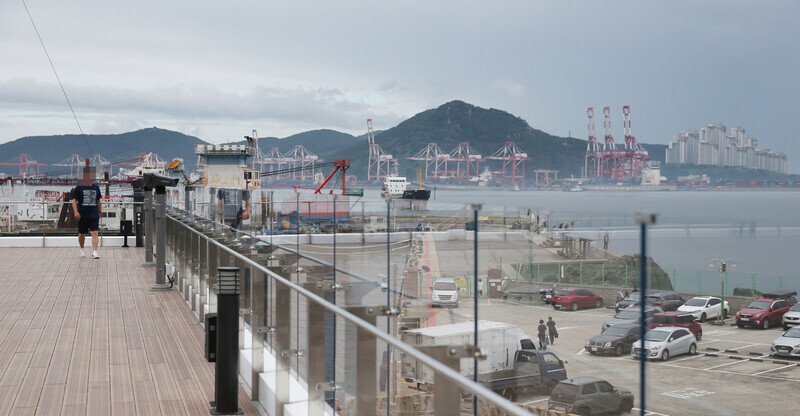
P.Ark is the creation of Ryu Jae-hak, the 41-year-old CEO of the ship repair company Jeil SR Group. Ryu is the son of the company’s founder Ryu In-seok. This explains why P.Ark looks a lot like a large cruise ship when seen from a distance.
Ryu Jae-hak is a Yeongdo native. He even graduated from Korea Maritime and Ocean University, which is located on the island. He explains that he built P.Ark because he “wanted to contribute to local development and to turn Yeongdo into a hub of Busan tourism.”
In 2021, Yeongdo District was listed alongside Busan’s Dong (East) and Seo (West) District by the Ministry of the Interior and Safety as one of 89 regions experiencing population decline.
But if its streets were once deserted, they have recently been filling again as the number of visitors grows year after year. A key factor in that has been the emergence of numerous cafés, P.Ark among them.
“In June 2012, Yeongdo had only 10 cafés. By June 2022, they numbered over 200,” said Son Min-su, an expert on local travel in Busan.
“They’ve also gained two new branches of Starbucks, a company that is very picky about locations,” he noted.

The cornerstone for Yeongdo’s coffee culture was laid early on by cafés like Momos Coffee and Cotton Diary, which took up residence at a pier for small ships in the city’s Bongnae neighborhood.
Wonji, which opened less than three months ago, has carried on P.Ark’s approach of scenery-based content. It was created in a converted dockside warehouse, with one of its walls given over to a large picture window that offers a view of the busy activities on the pier.
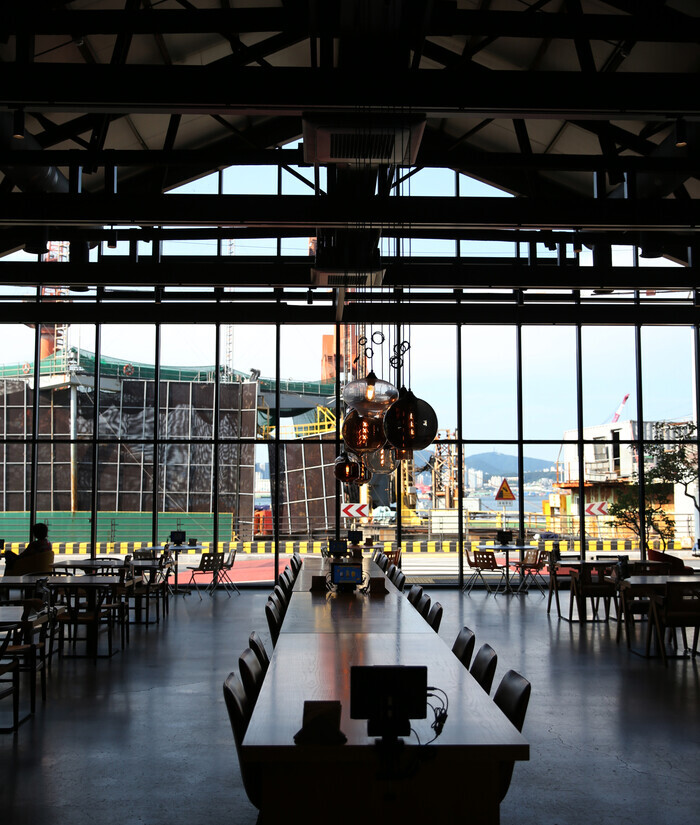
As a reflection of this trend, the city of Busan announced in July 2022 that it planned to turn a 600-meter section of Bongnae Naru Road near the pier into a specialized “coffee street.” In November, it held the first Yeongdo Coffee Festival.
Also enjoying popularity are coffee shops in the island’s Huinnyeoul Cultural Village, Kangkangee Arts Village, and Bongsan Village and on the slopes of Mount Bongnae. When it comes to coffee, Yeongdo has become a real “treasure island.”
Another sight awaiting Busan visitors is the string of coffee shops that have opened along the beaches of Gijang County.
Perhaps the most representative of these ocean view cafés is Waveon Coffee, which ushered in the Gijang “coffee village” culture with consistent success since its 2016 opening. It boasts unique scenery with its location by a cliff in the village of Wollae.
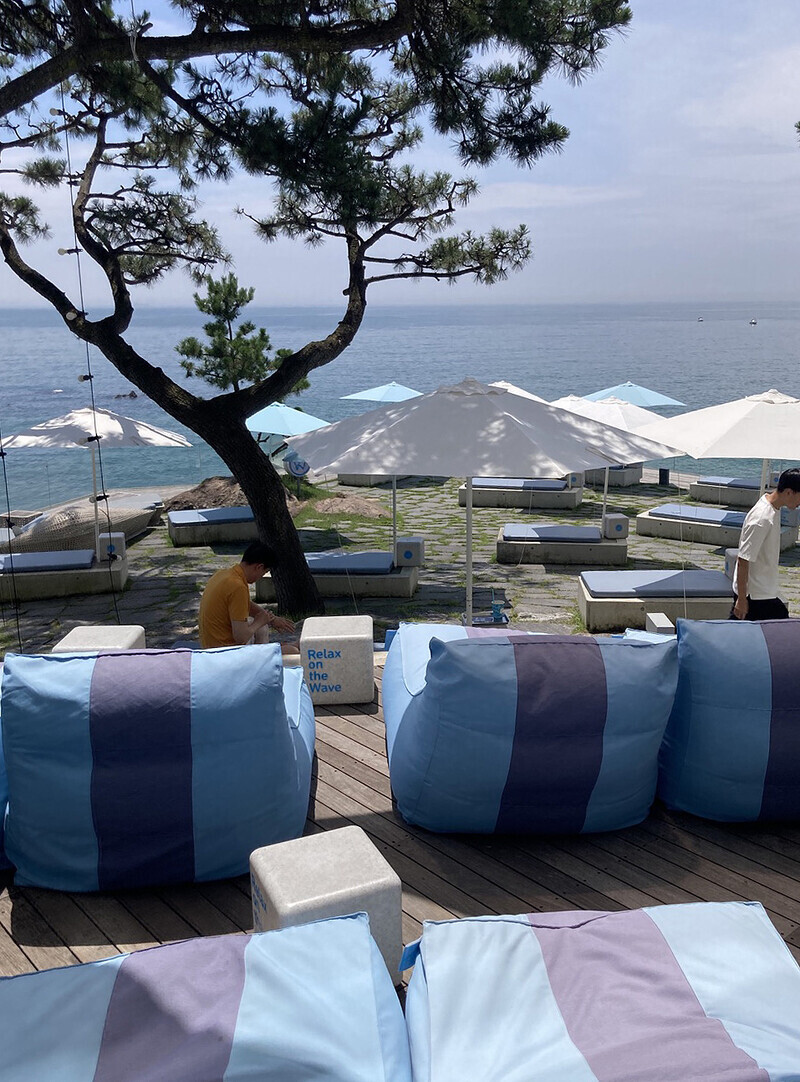
Another premier location is the outdoor courtyard, which is decked out with dozens of blue cushions. This place doesn’t just sell coffee — it offers a leisure experience where visitors can enjoy a pause in the company of the sea.
Waveon Coffee’s success touched off a boom that has seen dozens of new coffee shops appearing all the way south to Ilgwang Beach. Makesea, a combined café/bagel bakery, is located just on the edge of the water. D1 Bakery Café has attracted notice by setting up a photography spot with designs imitating the scenery of Greece’s Santorini Island.
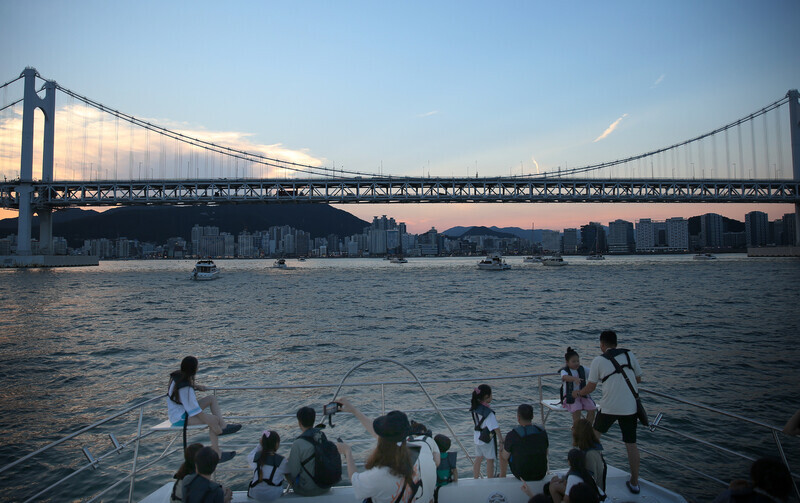
Even the same locations take on different looks for travelers during the day and nighttime. I visited at 7 pm on July 21 to board a Yo Company yacht anchored by the Suyeongman Bay Yachting Center. I was there for a nighttime tour, which I’d reserved the day before through the website of the travel agency Busan Special Travel Forces.
The tour is available in “public” and “private” options, where the private one involves renting the yacht to yourself. I went with “public.” The cost was 25,000 won for a little over an hour.
Currently, there are around 40 yacht tour companies operating in Busan. While the rates differ among them, they typically fall in the range of 25,000 to 30,000 won and up for an adult ticket.
Just before sunset, the sea was serene. On the yacht, the tunes of a troubadour were playing.
Captain Lee Ju-yeong, who has been doing this work for 10 years, explained, “Places like Jeju and Yeosu also have yacht tours, but Busan is the only one where you can really enjoy the cityscape at night.”
Lee took the helm, and the yacht slowly began heading out to sea. As dark continued to fall, it passed by the Nurimaru APEC House convention center, the high-rise buildings of Haeundae, Dalmaji Hill, the Oryuk Island, and Igidae on its way to Gwangan Bridge.
Hong Seung-wan, a 40-year-old company employee, said this was his second yacht tour in Busan.
His 9-year-old son, Ju-won, said, “This is my first time on a yacht. I like being able to see the sea from up close. It’s really thrilling.”
The passengers were a diverse group, including families, couples in their 20s and in middle age, as well as selfie-snapping solo travelers. Gwangan Bridge hove into view just as the red fabric of twilight was beginning to cloak the city. The lights of the cars on the bridge seemed like stars.
I could hear the lyrics of Cho Yong-pil’s song “Words of the Wind”: “Even when your kind heart is hurt / Life is warm.”
The last spectacle of the yacht tour was a firework display on the boat. It’s the sort of thing that might seem dangerous — but Yo Company CEO Hong Sang-gi explained, “It’s safe because they’re being exploded in the other direction where the wind is blowing.”
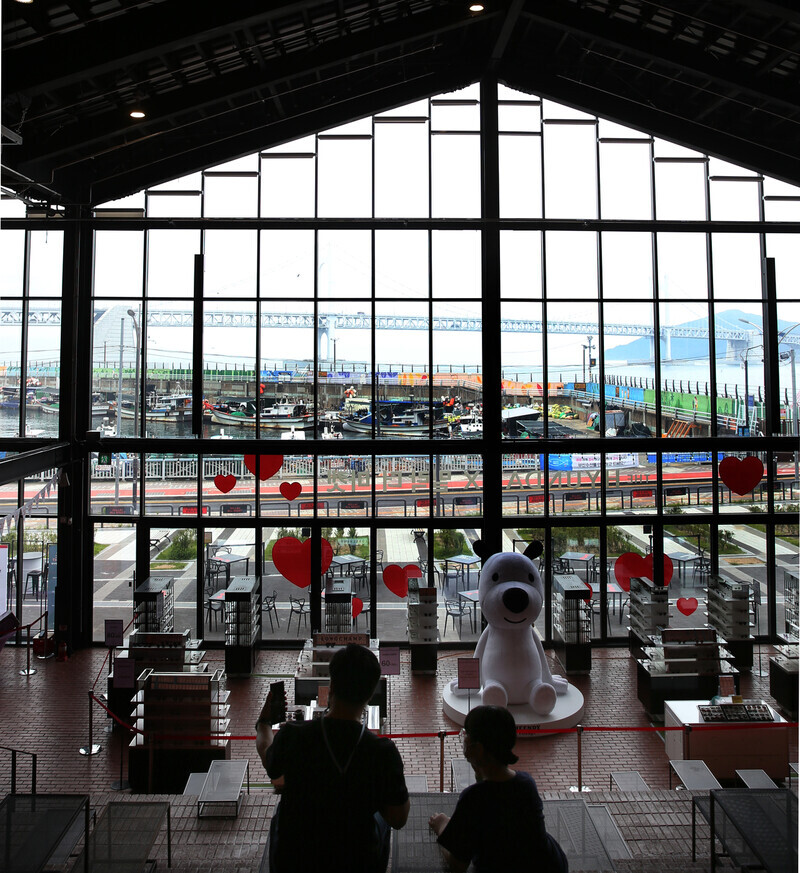
On July 22, I paid a visit to Millac the Market, which has emerged as a hot spot in the city’s Suyeong District — so popular that a long line had already formed even before the complex opened at 10 am.
The most eye-catching part was the terraced seating modeled on a Roman amphitheater. The scene visible through the picture window opposite it seemed like something out of a film noir. I could see an old ship awaiting repairs, and the image looked like the sort of place where the characters “Sergeant Kwon” (Zo In-sung) and Jang Do-ri (Park Jeong-min) might have had a brawl in the movie “Smugglers.”
The combined shopping center/cultural space was built by Kitchen Borie, the same company that operates The Bay 101 and Old Tree Market elsewhere in the city.
It was designed to resemble an old warehouse in New York, with a 4,447 m2 of floor area on a site measuring 7,722 m2. It includes a Starbucks and around 25 other businesses, among them the Vietnamese restaurant Lang, the highball bar D˚ (pronounced “dido”), and other eating establishments, clothing stores, and photography studios.
Another distinctive shopping destination that has been drawing notice is Village de Ananti, a resort/cultural space that opened on July 18. Besides the luxury accommodations, a big draw has been L.P. Crystal, a cultural space with a gross floor area of 19,834 square meters.
When I visited L.P. Crystal on July 20, I found a space designed to give the same feeling as traveling through the winding streets of a small European or American city.
A combined coffee shop and clothing store has been opened here by the brand Saint James, a company with a 130-year history that is seen as synonymous with the “nautical look.” The bookshop Hazel has shelves lined with art books and other distinctive publications.
The 86 select shop brands and 15 independent stores each offer a different color sense and a different take on interior designs. Also located here are food and beverage establishments like Le Blanc, Bakery, and Capote. On the basement level, the grocery store Moby Dick Market is of note to gourmands with its array of foods in unusual forms.
Village de Ananti is a village-style resort with an area of 160,000 m2 — twice the size of Ananti Cove next door. A total of 392 guestrooms are available, including villas, penthouse rooms, and the accommodations at the hotel Ananti at Busan. Besides the cultural space, it also boasts five swimming pools and 11 outdoor squares.
By Park Mee-hyang, staff reporter
Please direct questions or comments to [english@hani.co.kr]

Editorial・opinion
![[Column] Is Korean democracy really regressing? [Column] Is Korean democracy really regressing?](https://flexible.img.hani.co.kr/flexible/normal/500/300/imgdb/original/2024/0705/2917201664129137.jpg) [Column] Is Korean democracy really regressing?
[Column] Is Korean democracy really regressing?![[Column] How tragedy pervades weak links in Korean labor [Column] How tragedy pervades weak links in Korean labor](https://flexible.img.hani.co.kr/flexible/normal/500/300/imgdb/original/2024/0703/8717199957128458.jpg) [Column] How tragedy pervades weak links in Korean labor
[Column] How tragedy pervades weak links in Korean labor- [Column] How opposing war became a far-right policy
- [Editorial] Korea needs to adjust diplomatic course in preparation for a Trump comeback
- [Editorial] Silence won’t save Yoon
- [Column] The miscalculations that started the Korean War mustn’t be repeated
- [Correspondent’s column] China-Europe relations tested once more by EV war
- [Correspondent’s column] Who really created the new ‘axis of evil’?
- [Editorial] Exploiting foreign domestic workers won’t solve Korea’s birth rate problem
- [Column] Kim and Putin’s new world order
Most viewed articles
- 1Real-life heroes of “A Taxi Driver” pass away without having reunited
- 2[Column] Is Korean democracy really regressing?
- 310 days of torture: Korean mental patient’s restraints only removed after death
- 4Former bodyguard’s dark tale of marriage to Samsung royalty
- 5What will a super-weak yen mean for the Korean economy?
- 6[Reportage] Inside some of Korea’s 1,067 small towns facing extinction
- 7Koreans are getting taller, but half of Korean men are now considered obese
- 8[Photo] Twitter now lets users decide who can reply to their tweets
- 9S. Korea ranks 7th from bottom in happiness among OECD member states
- 10South Korea’s birth rate falls to 0.72, another new low